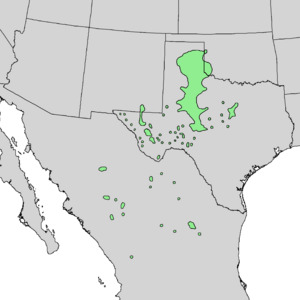Pinchot juniper facts for kids
Quick facts for kids Pinchot juniper |
|
|---|---|
 |
|
| Conservation status | |
| Scientific classification | |
| Genus: |
Juniperus
|
| Species: |
pinchotii
|
 |
|
| Natural range | |
| Synonyms | |
|
|
The Pinchot juniper (also called redberry juniper) is a type of juniper tree or shrub. Its scientific name is Juniperus pinchotii. It grows naturally in parts of southwestern North America. You can find it in Mexico (Nuevo León and Coahuila) and the United States. In the U.S., it grows in southeastern New Mexico, central Texas, and western Oklahoma. This plant likes to grow in places that are 600 to 2,100 meters (about 2,000 to 7,000 feet) above sea level.
About the Pinchot Juniper
The Pinchot juniper is an evergreen plant. This means its leaves stay green all year long. It is also a coniferous plant, which means it produces cones. It can grow as a shrub or a small tree. These plants usually reach 1 to 6 meters (about 3 to 20 feet) tall. They often have many stems and a full, rounded top.
Bark and Shoots
The bark of the Pinchot juniper is light gray. It peels off in long, thin strips. When the bark peels, you can see orange-brown color underneath. The small, new branches, called ultimate shoots, are about 1.1 to 1.8 millimeters thick.
Leaves
The leaves of the Pinchot juniper look like small scales. They are usually 1 to 2 millimeters long and 0.5 to 1.5 millimeters wide. On very strong, fast-growing shoots, the leaves can be up to 12 millimeters long. The leaves are arranged in groups of three or in opposite pairs. Young plants have needle-like leaves, but these change to scale-like as the plant gets older.
Cones and Reproduction
The cones of the Pinchot juniper look like berries. They have soft, sticky flesh. These cones are round or oval-shaped, about 5 to 8 millimeters long. Sometimes they can be up to 10 millimeters long. They are orange-red and often have a pale pink, waxy coating. Each cone usually holds one or two seeds. It takes about 12 months for the cones to fully grow after pollination.
Male cones are smaller, about 3 to 4 millimeters long. They release their pollen in the fall. Most Pinchot junipers are dioecious. This means that male cones grow on one plant, and female cones grow on a separate plant. However, sometimes you can find a plant that has both male and female cones. This is called a monoecious plant.
Plant Hybrids
Sometimes, different types of plants can mix their genes. When this happens, they create a new plant called a hybrid. Pinchot junipers are known to form hybrids with another juniper called Juniperus coahuilensis.
There have been reports of Pinchot junipers mixing with Juniperus monosperma. However, these reports have never been proven true. Scientists have tested these claimed hybrids, and they were not actually a mix of these two types. This is because Juniperus pinchotii and Juniperus monosperma cannot naturally create hybrids. They release their pollen at different times of the year. J. pinchotii releases pollen in the fall, while J. monosperma releases it in late winter.


